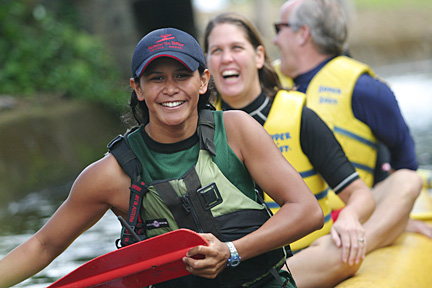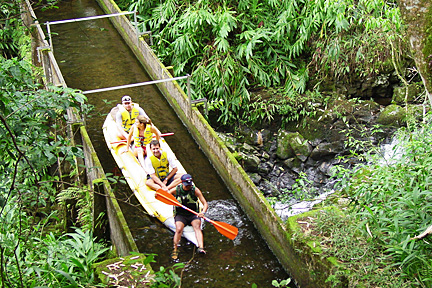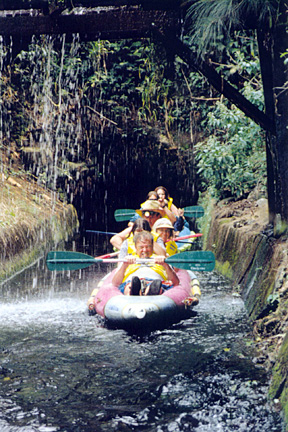
|
Hawaii’s
Back Yard |
Flum’in on
the Big Island
Whenever days in North Kohala on the Big Island got too hot and humid, Jordan Alejandro and his friends would head to "the ditch" to refresh themselves."Small-kid time, that was our stomping ground," says Alejandro. "We used to 'flume the ditch' with air mattresses, boogie boards, inner tubes -- anything that could float. We rode down different sections of it each time."
Flum'in Da DitchMeet at: Flum'in Da Ditch headquarters, 55-519 Hawi Road, Big IslandTime: Check-in is at 8:15 a.m. for a three-hour morning tour and 12:15 p.m. for the afternoon tour. Prices: $95 for adults and $65 for ages 5 through 18; includes a snack. Kamaaina rates are $69 for adults and $47.50 for children. Call: 808-889-6922 on the Big Island or toll-free 877-449-6922 from the other islands E-mail: res@flumindaditch.com Web site: www.flumindaditch.com Notes: This tour is not open to children under 5, those who suffer from claustrophobia and back problems, and pregnant women in their second or third trimesters. Wear clothes and footwear you don't mind getting wet. Bring a towel and change of clothes.
|
Alejandro is the chief guide for Kamuela Kayak Corp.'s Flum'in Da Ditch tour, which glides past pristine rain forests, over spectacular ravines and waterfalls and through long, dark tunnels along a scenic 3.5-mile portion of the Kohala Ditch.
"Mostly everyone who works for the company was born and raised in Kohala," says Alejandro. "It's like having a second family, and a lot of us played in the ditch when we were growing up. I'm really lucky to have a job in the area where I'm from, that shows people a good time and gives them a little education."
In addition to learning about the history of the ditch, participants get a close look at a variety of plants and trees, including awapuhi (ginger), ti, taro, albizia, coffee, mango, apple banana, guava, cinnamon and the kukui, Hawaii's state tree. Once in a while, ringneck pheasants, francolins, turkeys, peacocks, cattle and wild pigs can be seen foraging in the thick green foliage.
For many, the highlight of the leisurely kayak ride is drifting through 10 tunnels ranging in length from 100 to 1,800 feet.
On one wall of Wala Ohia, the fifth tunnel along the route, is a Japanese inscription that translates to "Victory for the Great Imperial Japan."
Amazingly, the words have endured for a century on the wet, rocky surface of the tunnel.
Says Alejandro: "A professor from Tokyo came to study it, and he said he believed it dates back to 1905, when the tunnel was being constructed and Japan was at war with Russia for control of Korea and Manchuria. Being all the way in Hawaii, the men who were building the ditch didn't know what was going on in the Russo-Japanese War, but this graffiti proves they were thinking about it."

A childhood discovery of fluming fun has turned into a major visitor attraction.
Another notable guest was the great-grandson of John Hind, the visionary plantation owner who played an instrumental role in building the system.
Several celebrities also have flumed the ditch, including Christie Brinkley, Sigourney Weaver, William Shatner, Jim Carrey and lanky David Robinson, who played for the NBA's San Antonio Spurs.
"I remember he was sitting in the middle of the boat, but his legs were hanging off the front end," recalls Alejandro.
Flum'in Da Ditch would not have flowed if it weren't for the efforts of landowner Surety Kohala Inc. and a few businessmen who were willing to take a chance on an innovative idea.
The last sugar plantation in Kohala closed in 1975. For the next 20 years, the irrigation water funneled by the ditch was used by only a few agricultural businesses.
"In 1996 a couple of entrepreneurs approached Surety, looking for business opportunities in the area," says Alejandro.
"Surety's projected business plan included ecotourism adventures such as hikes, horseback and mule rides, ATV tours and a kayak trip on the Kohala Ditch. They were seeking small investors to assume some of those business risks."
The entrepreneurs, including North Kohala resident Rodney Inaba, were fascinated by the history of the ditch and believed it provided all the ingredients for a unique activity. Inaba organized Kamuela Kayak Corp. to take on the project, and Flum'in Da Ditch was launched in December 1996 as a safe, fun family excursion that revived a fascinating part of Big Island history.
One of the original guides, Inaba now serves as general manager of Flum'in Da Ditch, which attracts some 22,000 visitors annually.
"Local people are interested in the tour because many of them either worked on the plantations or had connections to the plantations via family or friends," says Alejandro. "Visitors enjoy the opportunity to interact with the local guides as well as gain access to back-country regions that they would not otherwise be able to see."
He likes to tell the story of a 10-year-old mainland girl who went on Flum'in Da Ditch a few days after it started. "One of the guides asked what she had most enjoyed about the trip," he says.
"Her response captured the essence of the tour: 'It's fun and exciting like Disneyland, but it's real!'"

The Big Island's Kohala Ditch stretches 22.5 miles for three hours of sightseeing through rainforests, over ravines and waterfalls and through 6 miles of tunnels.
Herculean effort brought water from valleys to dry plains languishing in drought
At the turn of the last century, there were seven independent plantations cultivating approximately 10,000 acres of sugar cane in the Big Island's district of North Kohala.It takes a ton of water to produce one pound of refined sugar. Because of the drought that plagued the area at that time, some of the plantations were receiving only 15 to 25 inches of rain per year. As a result, yields were low, putting the plantations in financial jeopardy.
The solution to the problem seemed simple: transport water from the verdant valleys, where rainfall averaged 150 to 300 inches a year, to the dry plains where the cane fields were located. Engineers evaluated the feasibility of such an irrigation system and recommended against it due to heavy rainfall, rough terrain and unstable soil conditions.
Nevertheless, John Hind, one of the plantation owners, decided to proceed. He found an investor in Sam Parker, the grandson of John Parker (founder of Parker Ranch), who contributed about half of the $695,000 cost of the ditch. The balance of the money came from Hind and a few other entrepreneurs.
The group retained M.M. O'Shaughnessy, a noted civil and hydraulic engineer, to design and oversee the construction of the system. O'Shaughnessy hired 600 men, most of whom were Japanese immigrants, and work began in 1905.
At the 1,050-foot elevation -- in often cold, wet, windy conditions -- the laborers used dynamite, picks, shovels, hammers, chisels and their bare hands to painstakingly dig an average of 350 feet through the mountains each 12-hour workday. They lined the tunnels' walls with hand-cut rock and grout, and stabilized the ceilings with concrete.
When it was completed, the Kohala Ditch was hailed as an engineering marvel and received widespread acclaim.

Dress to get wet as tunnels and waterfalls are a source of splashing surprises.
E-mail to Travel Desk
[News] [Business] [Features] [Sports] [Editorial] [Do It Electric!]
[Classified Ads] [Search] [Subscribe] [Info] [Letter to Editor]
[Feedback]
